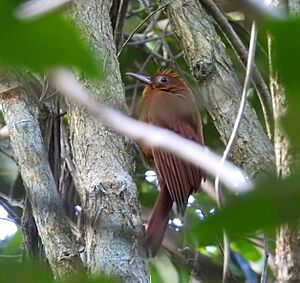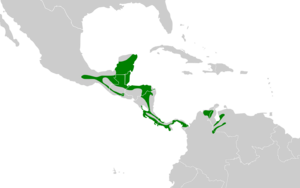Ruddy woodcreeper facts for kids
Quick facts for kids Ruddy woodcreeper |
|
|---|---|
 |
|
| Conservation status | |
| Scientific classification | |
| Genus: |
Dendrocincla
|
| Species: |
homochroa
|
 |
|
The ruddy woodcreeper (Dendrocincla homochroa) is a cool passerine bird. It's part of the ovenbird family called Furnariidae. You can find this bird from southern Mexico all the way to northern Colombia and extreme northern Venezuela.
Contents
About Its Family
Birds are often grouped into families and types. The ruddy woodcreeper belongs to a group called Dendrocincla homochroa. Scientists have found four slightly different kinds, or subspecies, of the ruddy woodcreeper. Think of them like different breeds of dogs, but for birds!
- D. h. homochroa (first described by Philip Sclater in 1860)
- D. h. acedesta (described by Harry C. Oberholser in 1904)
- D. h. ruficeps (described by Philip Sclater and Osbert Salvin in 1868)
- D. h. meridionalis (described by William H. Phelps Sr. and William H. Phelps Jr. in 1953)
Sometimes, scientists think that D. h. acedesta is so similar to D. h. homochroa that they might be the same.
What It Looks Like
The ruddy woodcreeper is about 17.5 to 20.5 centimeters (7 to 8 inches) long. That's about the length of a standard pencil! Males weigh between 34 and 45 grams (1.2 to 1.6 ounces). Females are a bit lighter, weighing 27 to 39 grams (0.95 to 1.4 ounces).
This bird is a medium-sized woodcreeper. It has a straight beak, a short tail, and a large head with ruffled feathers on its neck. Both male and female birds look the same.
The most common type, D. h. homochroa, has dark reddish-brown feathers on its upper body. Its head feathers are a brighter reddish color. Its wings and tail are also a reddish-brown. The tips of its main wing feathers are dark. It has grayish skin around its eyes and a light orange-brown throat. Its belly is a paler reddish-brown.
Other subspecies have slight differences:
- D. h. acedesta is bigger and darker than the common type. Its throat and belly are not as light.
- D. h. ruficeps is a little bigger than acedesta. It has a stronger beak and is slightly paler overall.
- D. h. meridionalis has a darker reddish-brown head. Its upper body is darker and more olive-brown than the others.
The ruddy woodcreeper's eye color can be reddish-brown to light chestnut-brown. Its legs and feet are pale grayish to grayish-brown. Its beak color can be different for each bird. It might be dusky brownish, grayish, dull pinkish with a black tip, or completely black.
Where It Lives and Its Home
The different types of ruddy woodcreepers live in specific areas:
- D. h. homochroa: Found in southern Mexico, and south through Belize, Guatemala, parts of El Salvador, Honduras, and into northeastern Nicaragua.
- D. h. acedesta: Lives on the Pacific coast from southwestern Nicaragua through Costa Rica into western Panama. It also lives on the Caribbean coast of northern and central Costa Rica.
- D. h. ruficeps: Found in central and eastern Panama, and a little bit into northwestern Colombia.
- D. h. meridionalis: Lives in northern Colombia and northwestern Venezuela.
This bird likes many kinds of forests. These include lowland forests, rainforests, cloudforests, and forests along rivers. It prefers the inside of old, untouched forests and forests that are growing back. But you can also find it at the edges of these forests. It sometimes lives in younger forests or open areas with some trees.
It usually lives in lowlands and foothills. In the northern parts of its range, it can be found at elevations between 1,300 and 1,550 meters (about 4,200 to 5,000 feet). In Central America, it can go as high as 1,650 meters (about 5,400 feet). However, it's most common between 300 and 1,200 meters (about 1,000 to 3,900 feet).
How It Behaves
Movement
The ruddy woodcreeper usually stays in the same area all year long. It might move to lower elevations in Central America sometimes. It could also move around a bit in northwestern Costa Rica.
Feeding Habits
The ruddy woodcreeper loves to follow army ant swarms. These ants stir up insects and other small creatures, which the bird then catches. It usually clings to a tree trunk up to 10 meters (33 feet) above the ground. From there, it makes short flights to grab its prey. It doesn't eat the ants themselves! Sometimes, it also looks for food in plants that grow on other trees. Usually, one or two ruddy woodcreepers will follow an ant swarm.
Reproduction and Life Cycle
The ruddy woodcreeper's breeding season changes depending on where it lives. But it generally happens between March and June. It builds its nest inside holes in tree stumps or tree trunks. It adds bark and other plant fibers to the bottom of the hole. If the hole is very deep, it might fill the bottom with moss or leaves first. A female bird usually lays two or three eggs. We don't know much about how long the eggs take to hatch or how long the young birds stay in the nest. We also don't know many details about how the parents care for their chicks.
Vocalization
The ruddy woodcreeper doesn't sing very often. When it does, it makes a "rattle" or "churring" sound. It also has different calls, like a squeaky "quink" or "peach," and a nasal, downward "deeeeah" or "tee tee eu."
Its Status
The IUCN (International Union for Conservation of Nature) says the ruddy woodcreeper is a bird of "Least Concern." This means it's not currently in danger of disappearing. It lives across a large area. Scientists estimate there are between 50,000 and 500,000 adult birds. However, this number is thought to be going down.
No immediate big threats have been found for this bird. From Mexico to Costa Rica, it's considered uncommon to fairly common. From Costa Rica to Panama, it's only common in certain places. It seems to be more common in Venezuela than in Colombia.
The ruddy woodcreeper is very sensitive to losing its forest home. If forests are cut down or broken into smaller pieces, the bird's numbers can drop. Even in good habitats, its numbers can change a lot. This might cause them to disappear from some areas.


